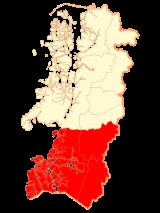
Capitán Prat Province
Encyclopedia
Capitán Prat Province is one of four provinces
in the southern Chile
an region of Aisén (XI). Its capital is Cochrane
. The province is named after the naval hero Arturo Prat
.
(INE), the province spans an area of 37043.6 sqkm and had a population of 3,837 inhabitants (2,154 men and 1,683 women), giving it a population density of 0.10 per km2 (0.3 per m2). At that time, 2,217 (57.8%) lived in urban areas and 1,620 (42.2%) in rural areas. Between the 1992 and 2002 censuses, the population grew by 1.5% (56 persons).
, governed by a provincial governor appointed by the president
. The province comprises three communes, each governed by a municipality, headed by an alcalde
: Cochrane, O'Higgins
and Tortel
.
Provinces of Chile
A province is the second largest administrative division in Chile, after a region. Each region is divided into provinces. There are 54 provinces in total....
in the southern Chile
Chile
Chile ,officially the Republic of Chile , is a country in South America occupying a long, narrow coastal strip between the Andes mountains to the east and the Pacific Ocean to the west. It borders Peru to the north, Bolivia to the northeast, Argentina to the east, and the Drake Passage in the far...
an region of Aisén (XI). Its capital is Cochrane
Cochrane, Chile
Cochrane is a Chilean town and commune in Capitán Prat Province of the Aisén Region. According to the 2002 census it has a population of 2,867. The urban population in 2002 was 2,217 and the rural population was 650....
. The province is named after the naval hero Arturo Prat
Arturo Prat
Agustín Arturo Prat Chacón was a Chilean navy officer. He was killed shortly after boarding the Peruvian armored monitor Huáscar at the Naval Battle of Iquique after the ship under his command, the Esmeralda, was rammed by the Peruvian monitor...
.
Geography and demography
It is Chile's eighth largest and fourth least populated province as well as the most sparsely populated province in continental Chile. According to the 2002 census by the National Statistics InstituteNational Statistics Institute (Chile)
The National Statistics Institute of Chile is a state-run organization of the Government of Chile, created in the second half of the 19th century and tasked with performing a general census of population and housing, then collecting, producing and publishing official demographic statistics of...
(INE), the province spans an area of 37043.6 sqkm and had a population of 3,837 inhabitants (2,154 men and 1,683 women), giving it a population density of 0.10 per km2 (0.3 per m2). At that time, 2,217 (57.8%) lived in urban areas and 1,620 (42.2%) in rural areas. Between the 1992 and 2002 censuses, the population grew by 1.5% (56 persons).
Administration
As a province, Capitán Prat is a second-level administrative divisionAdministrative divisions of Chile
The administrative division or territorial organization of Chile exemplifies characteristics of a unitary state. State administration is functionally and geographically decentralized, as appropriate for each authority in accordance with the law....
, governed by a provincial governor appointed by the president
President of Chile
The President of the Republic of Chile is both the head of state and the head of government of the Republic of Chile. The President is responsible of the government and state administration...
. The province comprises three communes, each governed by a municipality, headed by an alcalde
Alcalde
Alcalde , or Alcalde ordinario, is the traditional Spanish municipal magistrate, who had both judicial and administrative functions. An alcalde was, in the absence of a corregidor, the presiding officer of the Castilian cabildo and judge of first instance of a town...
: Cochrane, O'Higgins
O'Higgins, Chile
O'Higgins is a Chilean commune located around O'Higgins Lake in the south east of Aisén Region. The commune is administered by the municipality in Villa O'Higgins, the principal settlement.-Demographics:...
and Tortel
Tortel
Tortel is Chilean commune located at the outflow of Baker and Pascua River to the Pacific Ocean between the Northern and Southern Patagonian Ice Field...
.

